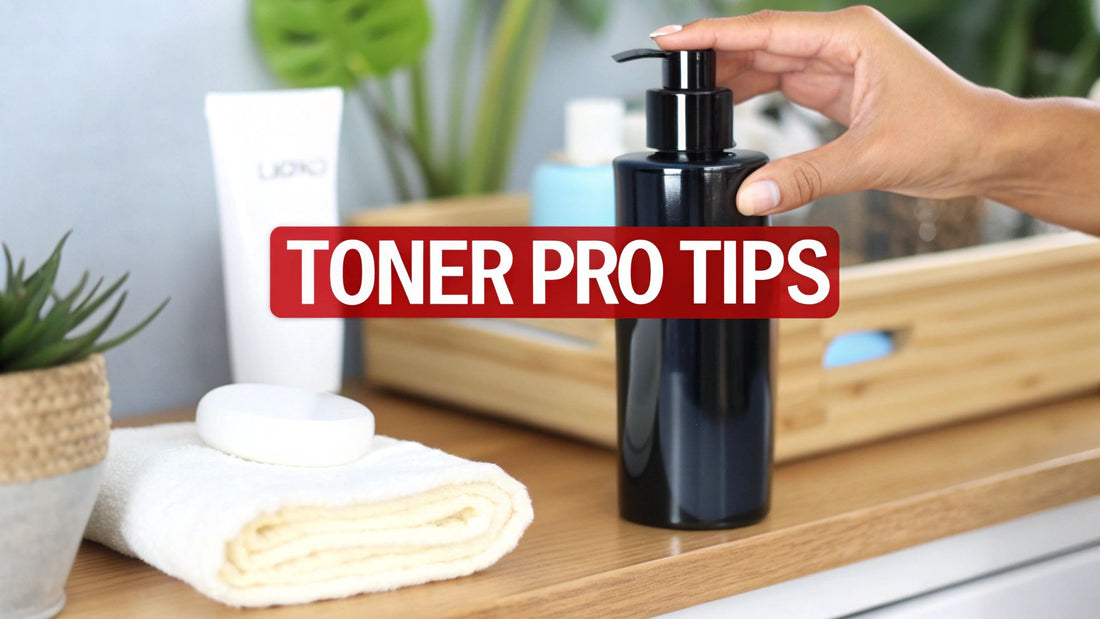
Unlock Radiant Skin: How to Apply Toner Like a Pro
Share
Why Your Toner Technique Makes All the Difference
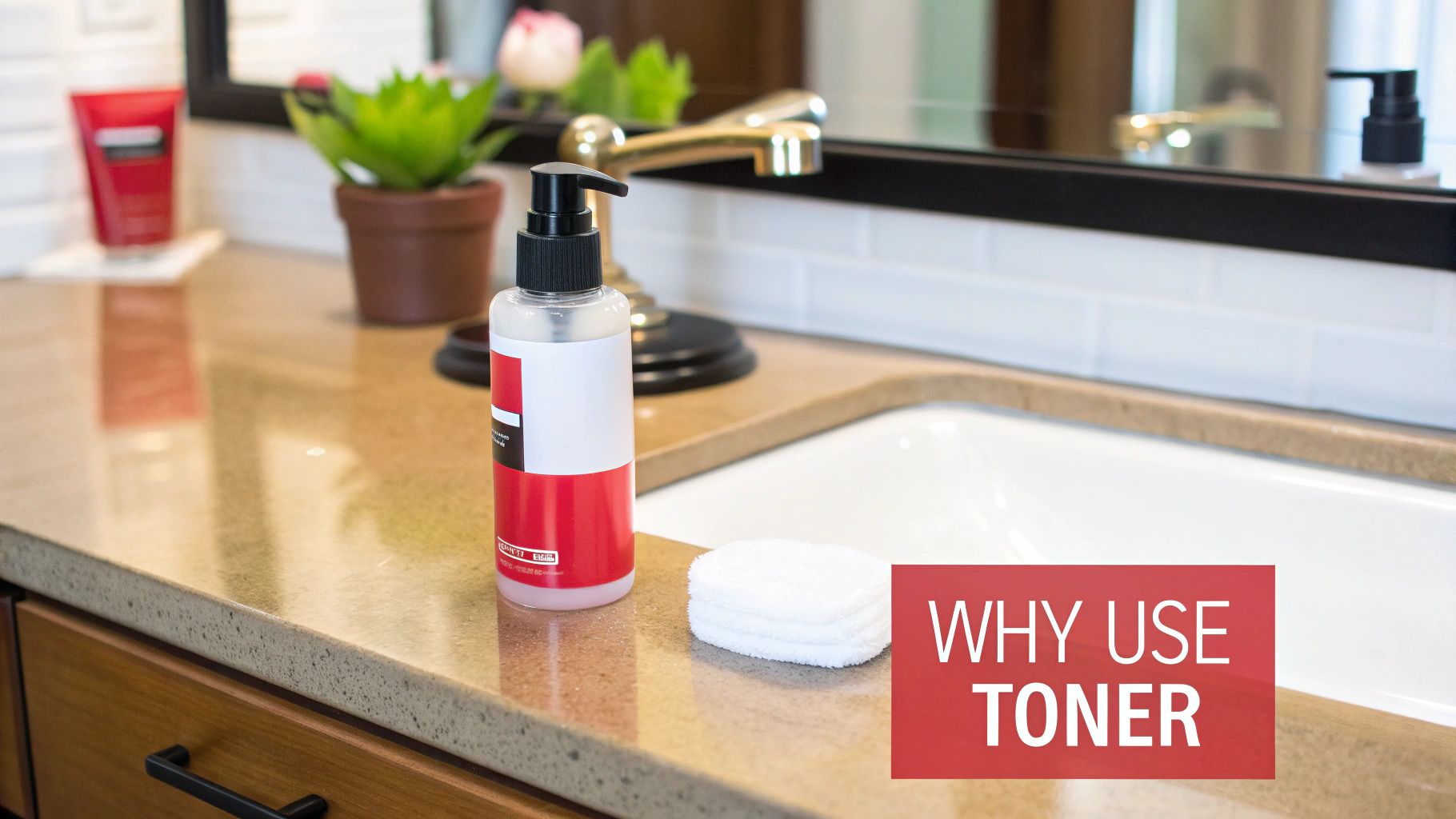
Many of us have wondered if toner is just a fancy, optional step in a skincare routine. The truth is, its real magic is unlocked in how you apply it. Picture your freshly cleansed skin as a dry sponge. If you just chuck water at it, most of it will simply run off. But if you dampen the sponge first, it absorbs liquid beautifully. Toner is that essential dampening step, getting your skin perfectly prepped to soak up all the goodness from your serums and moisturisers. This is why some people swear by their toner, while others feel like they're just pouring money down the drain—it often comes down to technique, not the product itself.
The moments right after you've cleansed are precious. Your skin’s pH balance is a little off-kilter and your pores are receptive, creating a small window of opportunity. Understanding how to apply toner correctly during this time means you’re not just wiping off leftover cleanser, but actively rebalancing your skin and delivering that first wave of hydration. The difference is something you can actually feel; the right method leaves your skin feeling plump and ready, whereas the wrong one can leave it feeling tight or even stripped.
The Rise of a Skincare Staple
This growing appreciation for toner's role is exactly why it’s becoming a non-negotiable step for so many skincare lovers. It's not just a feeling, either—the global skin toner market was valued at USD 1.25 billion in 2024, with Europe being the fastest-growing region. This trend isn't just about buying more products; it shows a real shift in knowledge. People now realise that the right toner is vital for hydrating, soothing, and priming the skin for everything that follows. You can discover more about this market growth at Mordor Intelligence. The main takeaway is clear: mastering your application is what transforms a simple liquid into a powerhouse product, making every single drop count towards healthier, glowing skin.
Finding Your Perfect Toner Match
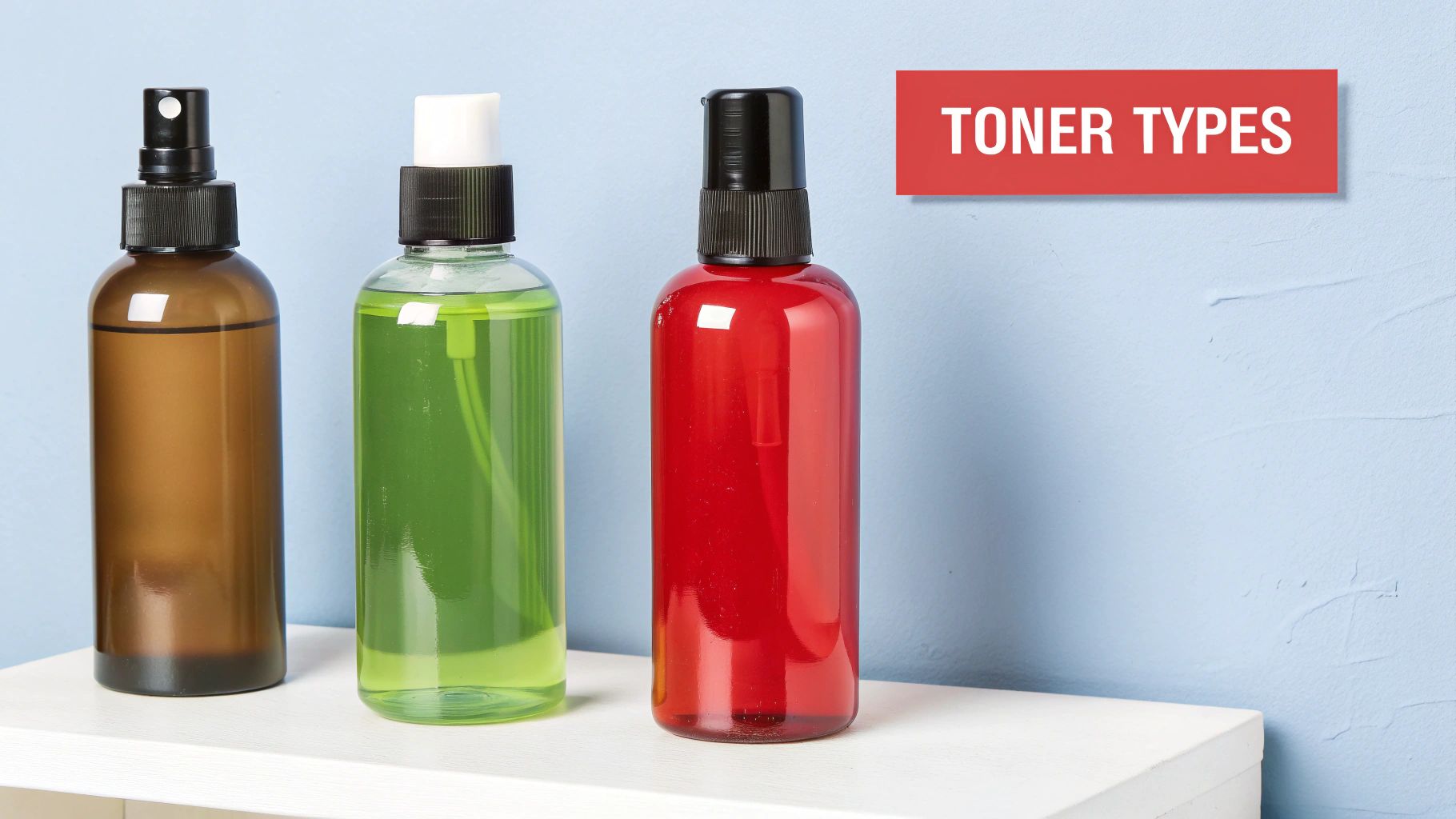 Before we even get into the how of applying toner, we need to talk about the what. Having the right toner for your skin is absolutely fundamental. Using a product that doesn't match your skin's needs is a bit like trying to fit a square peg in a round hole—it won't give you the results you want and might even make things worse.
Before we even get into the how of applying toner, we need to talk about the what. Having the right toner for your skin is absolutely fundamental. Using a product that doesn't match your skin's needs is a bit like trying to fit a square peg in a round hole—it won't give you the results you want and might even make things worse.
The world of toners has moved on from the harsh, alcohol-heavy liquids many of us remember. Today’s toners are sophisticated formulations designed for specific concerns. Learning to speak your skin's language is the first step to finding your ideal match.
Decoding Ingredients for Your Skin Type
Think of your skin as having its own unique personality. Some days it might be feeling oily, other days a bit sensitive. The ingredients in your toner should be chosen to suit these individual needs.
For instance, if you have oily or blemish-prone skin, your main goal is likely managing that extra shine and keeping pores clear. Look out for ingredients like salicylic acid (a BHA), which works wonders by exfoliating deep inside the pore. Witch hazel is a classic natural astringent, and niacinamide is another star player that helps regulate oil and reduce the look of pores without stripping the skin.
On the other hand, if you have dry or dehydrated skin, you'll want to avoid anything stripping. Your skin is craving moisture! Seek out hydrating heroes like hyaluronic acid, which famously holds up to 1000 times its weight in water, and glycerin. These ingredients are like a massive drink of water for your face, leaving it feeling plump, soft, and comfortable.
For those with sensitive skin, the aim is to calm and soothe. Ingredients such as centella asiatica (also known as cica), chamomile, and aloe vera are brilliant for reducing redness and irritation. If your skin is particularly reactive, it's worth exploring a dedicated skincare routine for sensitive skin, as this can truly transform your complexion.
To help you navigate the options, here’s a quick guide matching toner types to different skin concerns.
Toner Types by Skin Concern
A comprehensive comparison of different toner formulations matched to specific skin types and concerns
| Skin Type | Recommended Toner Type | Key Ingredients | Application Frequency |
|---|---|---|---|
| Oily / Blemish-Prone | Exfoliating & Clarifying | Salicylic Acid (BHA), Glycolic Acid (AHA), Niacinamide, Witch Hazel | 3-4 times a week, building up to daily if tolerated. |
| Dry / Dehydrated | Hydrating & Nourishing | Hyaluronic Acid, Glycerin, Ceramides, Rose Water | Twice daily (morning and night). |
| Sensitive | Soothing & Calming | Centella Asiatica (Cica), Chamomile, Aloe Vera, Oat Kernel Extract | Twice daily (morning and night). |
| Combination | Balancing & Hydrating | Green Tea, Niacinamide, Hyaluronic Acid | Twice daily, focusing on specific areas as needed. |
| Mature | Anti-Ageing & Firming | Peptides, Antioxidants (Vitamin C, E), Retinoids (gentle forms) | Once or twice daily, depending on ingredient potency. |
This table shows how specific ingredients are better suited for certain skin types. An exfoliating toner is great for oily skin but could be too much for dry skin, which thrives on hydrating ingredients.
The Trial-and-Error Journey
Finding "the one" when it comes to toners can sometimes take a bit of experimenting. A clear sign that a toner isn't right for you is any feeling of burning, stinging, or uncomfortable tightness after you've used it. Your skin should feel refreshed and balanced, not stripped bare.
Remember to consider the seasons, too. The light, clarifying toner that feels amazing during a humid summer might be too harsh for your skin in the middle of a centrally heated winter. It's perfectly fine—and actually quite clever—to have a couple of different toners in your cabinet to meet your skin's needs as they change throughout the year.
Mastering the Art of Toner Application
So, you’ve found your perfect toner! That’s brilliant, but the journey doesn't stop there. Knowing how to apply it is what truly separates a good skincare routine from a great one. The right technique ensures every precious drop gets to work deep within your skin, rather than just evaporating or getting wiped away.
Before you even unscrew the cap, let's talk prep. Think of your face as a canvas. For your toner to perform at its best, that canvas needs to be clean and ready. This means cleansing thoroughly and, if it’s an exfoliation day, doing that first. Once you’re done, gently pat your skin dry.
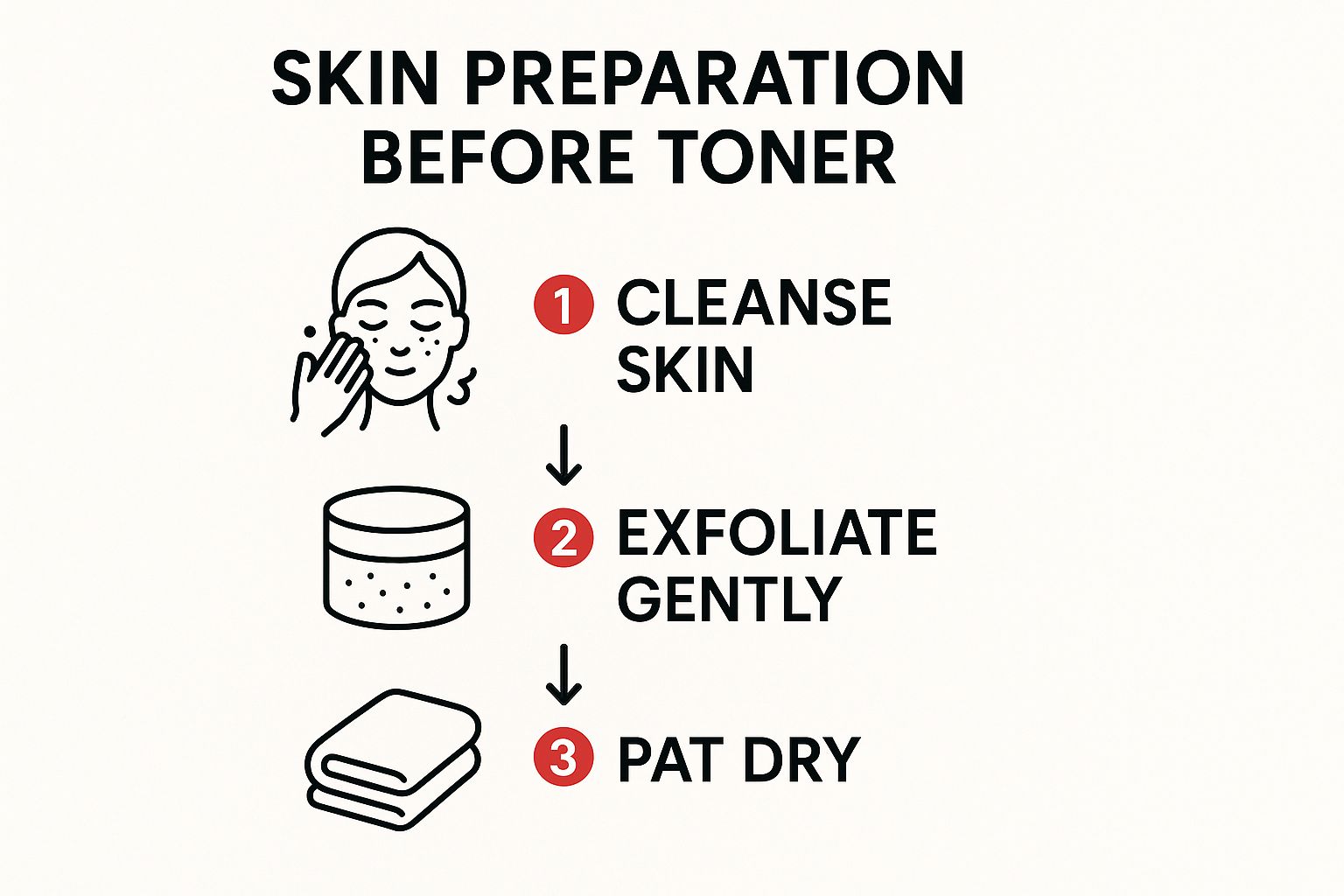
This simple sequence clears away any barriers like dirt, oil, or dead skin cells, giving your toner a direct path to do its job effectively.
Your Hands vs. Cotton Pads: The Great Debate
One of the most common questions I hear is whether it's better to use your hands or a cotton pad. Honestly, it depends on the toner's texture and what you want it to achieve.
- For thin, watery toners: I almost always recommend using your clean hands. Pour a small amount, about the size of a 50p coin, into your palm. Rub your palms together briefly, then gently press the toner into your face and neck. This method is fantastic because you waste less product and the pressing motion really helps with absorption.
- For exfoliating or clarifying toners: A reusable cotton or bamboo pad is your best friend here. These toners often contain acids like AHAs or BHAs. Wiping it on with a pad gives you a final, gentle sweep of exfoliation, catching any last traces of impurities your cleanser might have missed and ensuring the active ingredients are distributed evenly.
This image shows the exact gentle patting motion I’m talking about for hydrating toners. It’s a game-changer for avoiding unnecessary pulling or irritation.

This technique is especially kind to sensitive skin, as rubbing can often cause redness and stress to the skin barrier.
Timing and Layering for Maximum Impact
Once your toner is on, don't just dive straight in with your next product. Give your skin a moment to drink it all in. I find waiting about 30 to 60 seconds is perfect. Your skin should feel damp and plump, but not sopping wet.
This is the golden window to apply your serums. The layer of toner creates a hydrated pathway, allowing your serums to penetrate much more deeply and work more efficiently. If you're looking to build a full routine that really makes your skin sing, our guide on how to get naturally glowing skin has some wonderful tips. By paying attention to these small details in application, you turn your toner from a simple liquid into a powerful step toward achieving the skin you've always wanted.
Building Sustainable Toner Habits That Stick
The true secret to getting that healthy glow from your toner isn’t some miracle ingredient; it's consistency. Let's be honest, a routine that’s realistic and that you can actually stick to is far better than a perfect, complicated one you'll give up on after a week. Learning how to apply toner in a way that feels like a natural part of your day, not just another chore, is what leads to real, lasting results.
And you're not alone in making toner a staple. It's a growing movement. Research has shown that over 60% of UK women between 25 and 45 now use a toner regularly. That’s a massive increase from less than 40% just a decade ago. This shift shows a much deeper appreciation for the benefits of a complete skincare routine. You can read more about this trend in the full report from Cosmetics Business, which really highlights that sticking with it is what pays off.
Making Toner a Daily Ritual
So, how do you get this new habit to stick? The trick is to link it to something you already do without thinking.
- Your Morning Cue: Pop your toner bottle right next to your toothbrush. This simple visual reminder prompts you to use it right after cleansing, before your brain has a chance to wander off to your to-do list or that first cup of coffee. This is a classic "habit stacking" technique, and it works because it makes the new step feel almost automatic.
- An Evening Wind-Down: Think of your evening toner application as a small act of self-care. Instead of it being just another task on your list, reframe it as a mini-facial. Use gentle, pressing motions, take a few deep breaths, and really enjoy the calming sensation. It can become a lovely signal to your brain and body that it's time to unwind.
Adapting to Life's Interruptions
Let's face it, life rarely runs on a perfect schedule, but that doesn't mean your routine has to fall apart. A flexible approach is a resilient one. If you’re travelling, simply decant your favourite toner into a small spray bottle for a quick, refreshing spritz on the go. Had a long, draining day and the thought of a full routine is just too much? Just cleanse and tone. Adopting a "something is better than nothing" mindset keeps the habit alive.
If you’re keen on keeping your routine sustainable even when you travel, our eco-friendly skincare guide has some great tips. By being adaptable, you build a routine that truly works for you, no matter what life throws your way.
Avoiding the Mistakes That Sabotage Your Results
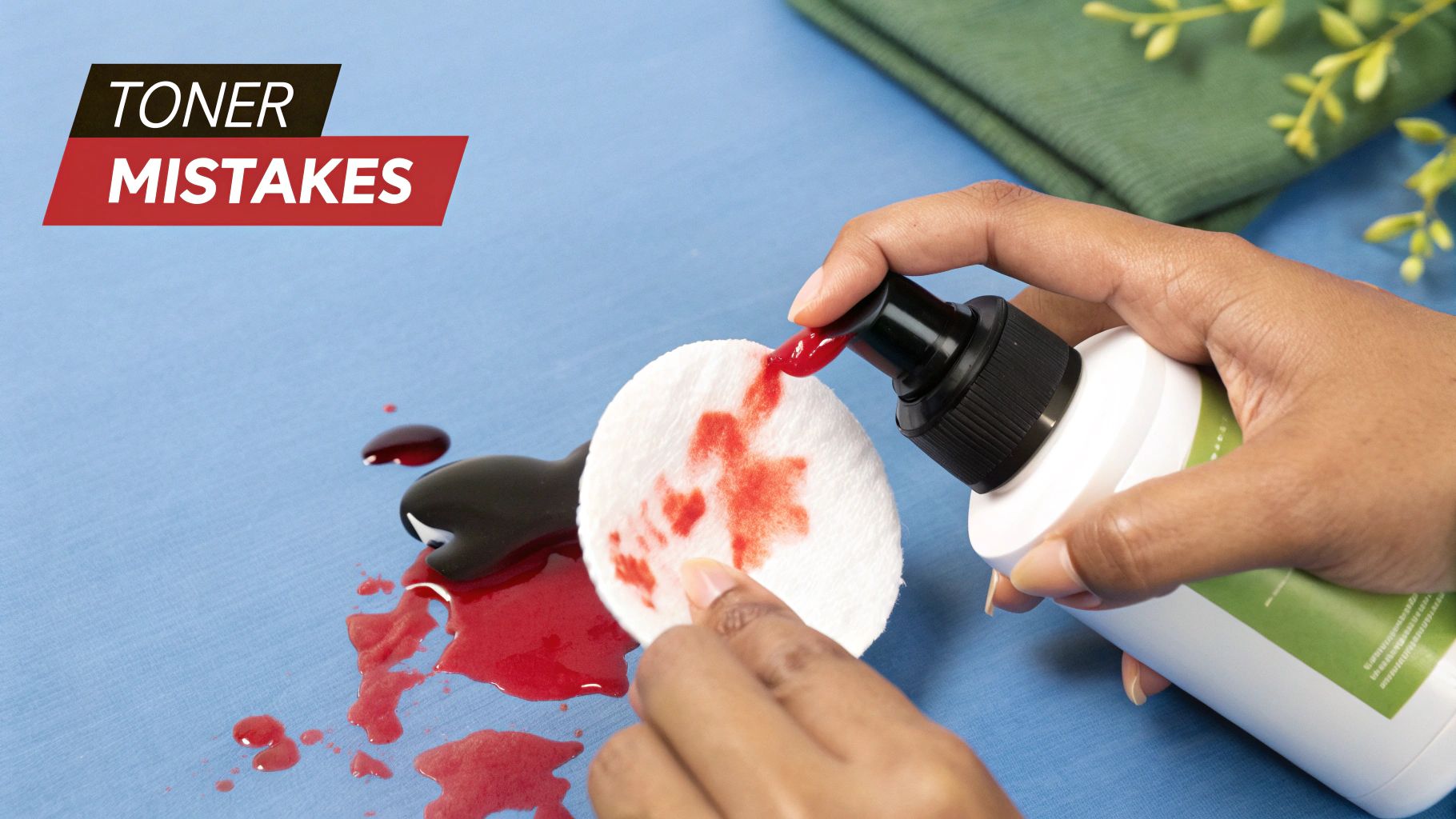 Even when you’ve found the perfect toner and have a decent application method, small mistakes can quietly undo all your hard work. Learning how to apply toner is as much about knowing what not to do as it is about the right technique. The good news? Most common slip-ups are surprisingly easy to fix once you know what to look for.
Even when you’ve found the perfect toner and have a decent application method, small mistakes can quietly undo all your hard work. Learning how to apply toner is as much about knowing what not to do as it is about the right technique. The good news? Most common slip-ups are surprisingly easy to fix once you know what to look for.
It’s clear we’re taking our skincare more seriously here in the UK. The facial skincare market grew by an impressive 7.9% in 2024, and sales of premium products shot up by 12% in early 2025. As we can see from UK skincare market trends from Mintel, people are happy to invest in quality. With that in mind, it’s vital to make sure our application technique lets these fantastic products do their job.
Recognising Common Toner Missteps
Sometimes, the biggest improvements come from the smallest adjustments. A classic mistake is simply using too much product. It’s tempting to drench a cotton pad or pour a large puddle into your palm, thinking more toner means better results. In reality, it just wastes a good product and can oversaturate your skin, making it difficult for your serums and moisturisers to absorb afterwards. A 50p-sized amount is all you need.
Another subtle saboteur is the world around you. Ever notice your skin feeling extra tight in the winter? It's not just your imagination. Central heating and cold, dry air can suck the moisture right out of your skin, meaning your trusty hydrating toner might suddenly not feel like enough. Even hard water can leave behind mineral deposits that get in the way of product absorption. Paying attention to these external factors allows you to adapt. You might need to apply a couple of layers of your hydrating toner or switch to a richer formula when the weather turns. It’s all about listening to what your skin is telling you day-to-day.
To help you sidestep these common issues, we’ve put together a quick guide to identify and fix the most frequent toner application errors.
Common Toner Mistakes and Solutions
Identifying and fixing the most frequent toner application errors that reduce effectiveness
| Common Mistake | Why It Happens | Quick Fix | Long-term Solution |
|---|---|---|---|
| Using Too Much Product | The belief that more product equals better results. | Use a 50p-sized amount. Pour it into your palm instead of onto a cotton pad to avoid waste. | Measure out your toner for a week to get used to the right amount. Trust that a little goes a long way. |
| Applying to Dry Skin | Waiting too long after cleansing allows the skin to dry out completely, making it less receptive. | Apply toner within 60 seconds of patting your face dry after cleansing, while it’s still slightly damp. | Make toner application an immediate next step in your routine. Keep your toner next to your cleanser as a visual reminder. |
| Rubbing Too Vigorously | Using too much friction with a cotton pad can cause irritation, redness, and micro-tears. | Gently sweep the cotton pad outwards or press and pat the toner into the skin with your hands. | Switch to the "press and pat" method with your hands to minimise friction and improve absorption. |
| Using the Wrong Toner for Your Skin Type | Choosing a toner with harsh ingredients (like high-alcohol content for dry skin) can worsen existing issues. | Stop using the product if you feel stinging or see redness. Switch to a soothing, alcohol-free formula. | Research ingredients that suit your skin type (e.g., salicylic acid for oily skin, hyaluronic acid for dry skin) and read labels carefully. |
| Inconsistent Application | Skipping toner application disrupts the skin's pH balance and hydration levels. | Use your toner every time you cleanse, both morning and night. | Think of toner as the essential prep step for the rest of your routine, not an optional extra. Set a reminder if needed. |
By being mindful of these small details, you ensure your toner works as a supportive step in your routine, rather than an accidental hindrance. A thoughtful approach is what truly leads to glowing, healthy-looking skin.
Your Personal Toner Success Blueprint
Alright, let's bring everything we've talked about together and build a routine that actually works for you. Creating a skincare plan that sticks is less about following every trend you see online and more about smart observation and consistency. It’s about creating a personal success story for your skin.
Getting Started and Tracking Progress
To avoid feeling overwhelmed, start with just one clear goal. Is it calming down redness? Getting a brighter complexion? Tackling dryness? Pick one and focus on that. It's important to be realistic with timelines, too. You might see a reduction in redness within a few days, but changes to skin texture can often take four to six weeks of dedicated use to become noticeable.
So, how do you really know if it’s working? You need to track it, and memory alone won’t cut it.
- Keep a Simple Journal: After you apply your toner, jot down a few words about how your skin feels. Is it plump and happy, a bit tight, or noticeably calmer?
- Take Weekly Photos: Try to use the same lighting and angle each time. This gives you an honest, side-by-side comparison of how your skin is changing over time.
- Listen to Your Skin: Beyond the mirror, pay attention to the little things. Is your skin less reactive to your makeup? Does your moisturiser seem to sink in better? These are fantastic signs that you’re on the right track.
This simple approach gives you real evidence to work with, allowing you to make adjustments based on what your skin is telling you, not just what's popular at the moment.
Maintaining Your Routine for the Long Haul
Life happens, and routines can get disrupted. When you're going through a busy patch, simplify things. A quick cleanse followed by pressing in some toner is so much better than skipping your routine altogether. Your skin's needs will also change with the seasons, stress levels, or travel. Be ready to adapt, perhaps by adding an extra layer of toner in winter or switching to a lighter one in summer.
If you’ve been consistent for a couple of months and still aren't seeing the results you hoped for, it might be the perfect time to get some professional advice. A consultation with a dermatologist can be a brilliant investment to fine-tune your approach. This roadmap helps you start smart, stay on track, and build a positive, lasting relationship with your skin.
Discover Your Perfect Toner Ritual: The LULUMINE Collection
For Deep Hydration & Soothing
-
Hydrating Toner
Instantly replenishes moisture and calms sensitive or dry skin with botanical extracts and a refreshing, alcohol-free formula. -
Hydrating Serum
Layer after toner for a boost of lasting hydration and plump, dewy radiance.
For Clarifying & Oil Control
-
Purifying Toner
Balances and refines pores, helping to clear congestion and control shine—ideal for oily or blemish-prone skin. -
Glycolic Acid Liquid Exfoliator
Gently exfoliates to reveal a brighter, smoother complexion. Use 1–2 times per week after cleansing, before toner.
For Brightening & Even Tone
-
Pigment Perfecting Serum
Targets dark spots and uneven tone—apply after toner for a luminous, even glow.
For Age-Defying & Firming
-
Botox-Like Peptide Serum
Smooths and visibly firms skin; layer after toner for a plump, revitalized look. -
Niacinamide Gel Moisturiser
Locks in hydration and reinforces the skin barrier, perfect as the final step after your toner and serum.
All LULUMINE products are vegan, cruelty-free, and formulated for even the most sensitive skin. Explore the full collection and embrace your most radiant, healthy-looking skin—naturally.
